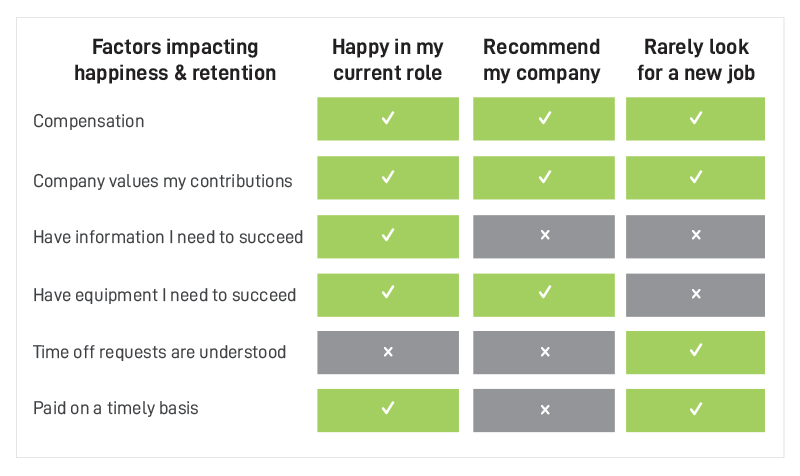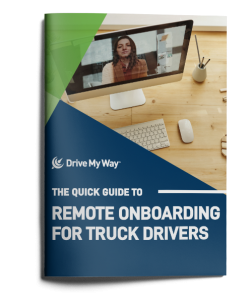 According to Drive My Way’s Truck Driver Happiness and Retention Survey, only 54% of surveyed drivers say they are happy with their job. Younger and newer drivers expressed higher levels of happiness than older, more experienced drivers. In addition, females expressed higher satisfaction levels as did those working for larger companies.
According to Drive My Way’s Truck Driver Happiness and Retention Survey, only 54% of surveyed drivers say they are happy with their job. Younger and newer drivers expressed higher levels of happiness than older, more experienced drivers. In addition, females expressed higher satisfaction levels as did those working for larger companies.

Beth Potratz, CEO of Drive My Way shares: “Too many CDL drivers are not happy with their job. A truck driver’s life and job are inextricably connected, therefore it’s critical their job fits their needs and preferences so they can live the life they want doing the job they love.”
Taking that research into account, you might also wonder how the size of the employer might affect happiness and retention. What might make a smaller company an attractive place for a driver to work? What gives small carriers an advantage over larger carriers? In this case, there’s plenty of things that a smaller company can use to its advantage when working to recruit and retain great truck drivers. Here we’ll take a look at 4 little ways to engage drivers at a small trucking business.
1. Show Drivers You Care
Showing signs of appreciation for your drivers should be part of any company’s overall culture. Though grand gestures of appreciation are usually well-received, it’s the smaller things that standout. The things that make life easier on a daily basis that can make the most difference. A simple thank you goes a long way to keep employees feeling appreciated and engaged. Investments in continuing driver education help driver know you value them. Being respectful of scheduling requests makes your drivers feel respected. These are the little things that a small trucking business can do well to compete for driver loyalty. Take a look at the list below, which of these things do you use to your advantage?
Small trucking companies have the following advantages:
- Know your drivers by name
- Family-first culture
- Flexibility
- Close-knit teams
- Less layers and bureaucracy
- More meaningful interactions
- Plenty of opportunity to grow
2. Open Lines of Communication
Communicate with drivers effectively and ask to hear their opinion on crucial topics such as compensation, equipment, and home time. Showing that you care about your drivers is important. If you give your drivers ways to supply their feedback, this can encourage further driver engagement as well.
As a small trucking business, you can really highlight the intangibles that make working for you attractive. If you’ve got a great home time policy, be sure to include and communicate that. Tell prospective employees about the things you provide that larger carriers cannot. These indirect forms of compensation are something to communicate when recruiting new drivers.
Whenever someone is asked for their opinion on something that’s important, it makes them more connected to the decision-making. And ultimately connected and invested in the way the company performs. All of these things add to the value perceived by your drivers, and should be communicated as a part of their total compensation when they join your team.
3. Prioritize What Makes Drivers Happy
Does it matter if drivers are happy? Drive My Way’s Truck Driver Happiness and Retention Survey indicates that driver job satisfaction, retention, and recruiting are strongly interconnected. Not only are happy drivers more likely to stay with your company, but they are also more likely to recommend and help recruit your next driver hire.
Asking your employees about happiness is a great indicator of turnover risk. Investing in the satisfaction of your drivers can have a big payoff in both retention and recruiting.

What makes a driver happy?
This graphic from the Truck Driver Happiness and Retention Survey shows what makes truck drivers happy, and which factors impact their retention more than others.
Are you making these things a priority in your current driver strategy? What changes should you make?
4. Advancement Opportunities
There are a few great ways to help a new driver know that if they join your carrier, they can have long and fulfilling career with you. Implementing mentorship programs and having a driver career path established will help a driver picture how they will fit in and grow with your company over the long-haul.
Mentorship programs are great tools for your small trucking business. They help engage new drivers by having a designated person to show the the rope. And it also gives your current drivers an opportunity to share what they know to help a new driver get established. These relationships can be very mutually beneficial for the drivers, and certainly valuable for company culture and employee retention.
Having a mentor, and also having an established career path to follow can help a driver become connected early and know that they’ve made a great decision to be with you for many years and many, many miles.
If you’re just getting started, or if you’re a well-established small trucking business, you most certainly have advantages to use in your favor while building your team of drivers. Lean into the strengths and advantages that are unique to a trucking company of your size and do the things that larger carriers simply cannot. Word of mouth is a great tactic to help you attract and retain drivers when you’re small or just getting started.




 Unfortunately,
Unfortunately, 

 To support strong mental health in your fleet, support good dietary and
To support strong mental health in your fleet, support good dietary and  Having strong, healthy relationships is closely linked with positive mental health. That extends far beyond the walls of the home. Build a company
Having strong, healthy relationships is closely linked with positive mental health. That extends far beyond the walls of the home. Build a company 


 Home time should be clearly stated in the hiring contract. While it may seem unnecessary, putting home time in writing is good protection for both the company and drivers. If your policy is in writing, it ensures consistency among drivers. If you do have
Home time should be clearly stated in the hiring contract. While it may seem unnecessary, putting home time in writing is good protection for both the company and drivers. If your policy is in writing, it ensures consistency among drivers. If you do have  If drivers stay with your fleet for long enough, they will likely request time at home outside their typical policy at some point. Additionally, new drivers might ask about for more time at home in a hiring interview. Before those conversations arise, consider how you can offer flexibility in a way that works with you.
If drivers stay with your fleet for long enough, they will likely request time at home outside their typical policy at some point. Additionally, new drivers might ask about for more time at home in a hiring interview. Before those conversations arise, consider how you can offer flexibility in a way that works with you. 














